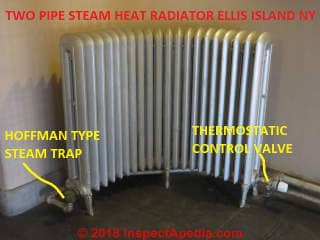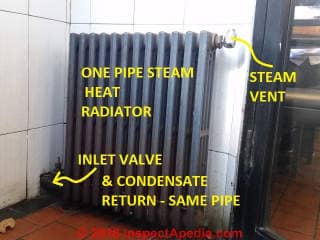 Steam Vents on Steam Heating Radiators & Steam Pipes
Steam Vents on Steam Heating Radiators & Steam Pipes
Home Page - how they work; how to diagnose & fix steam vents that won't open, won't close, hiss, or leak
- POST a QUESTION or COMMENT about steam vents on steam heating radiators and convectors
Steam vents on heating systems:
Here we provide an inspection and repair guide to the vents found on radiators and piping used with steam heating systems.
We explain one pipe and two pipe steam heating vents and how they work, and the article includes diagnostic and repair advice for hissing sounds at steam radiators, steam vents that don't close when they should, steam vents that don't open when they should, noisy steam vents, and steam vent leaking or spitting.
We describe how to identify, service, or repair steam radiator air vents. How to regulate heat using air vents on steam radiators & troubleshooting steam heating system radiator vents & controls. How do we know if the steam vent is working on a radiator?
InspectAPedia tolerates no conflicts of interest. We have no relationship with advertisers, products, or services discussed at this website.
Guide to Steam Vents on Residential Heating Systems
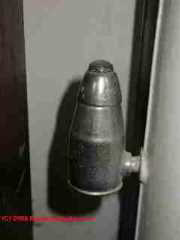 Article Contents:
Article Contents:
- HOW DO STEAM VENTS WORK
- HISSING SOUNDS AT STEAM RADIATORS
- STEAM VENTS THAT DO NOT SHUT OFF WHEN THEY SHOULD
- STEAM VENTS THAT DO NOT OPEN WHEN THEY SHOULD
- NOISY STEAM VENTS OR STEAM RADIATORS
- STEAM VENTS THAT LEAK OR SPIT WATER
Our photo (above left) shows what looks like a Hofman 1A float-type radiator steam vent. This is a residential low-pressure (1.5 psig) steam vent. Similar models include the Hoffman Model 40 (6 psig) and model 70A (11 psig).
[Click to enlarge any image]
Steam Vent Safety Warning
Watch out: Never remove a steam vent nor any other fitting or plug from a steam radiator if the heating system is hot and/or in use. Both the hot radiators and steam itself can cause serious burns. If you are not trained to do so, do not attempt to adjust or remove steam vents or control valves on steam heating radiators.
Even something as simple as removing a non-functioning radiator steam vent to try to allow air to escape and thus allow the radiator to heat up can be very dangerous.
At first it seems easy: remove the steam vent and rising steam in the system will push air out of the radiator. But suddenly things turn ugly.
When steam begins to enter the radiator it finds and streams out of the opening from which the steam vent was removed.
At that point it becomes essentially impossible to re-install the steam vent because you're reaching into a plume of boiling hot steam!
See COLD STEAM HEAT RADIATORS if you need to fix a cold radiator using safer and more-effective means. .
In 2017 the New York Times reported on the steam heat scalding deaths of two girls in the Bronx. The article gave no details about exactly what went wrong but the article states, "Ibanez, 2 and Scylee, 1, were scalded to death on Dec. 7 by radiator steam in a city-funded apartment for the homeless in the Bronx.
A valve on the radiator in their bedroom had come off; ..." - Neuman, William, "Parents Sue in Deaths of 2 Girls From Scalding", The New York Times, 16 Dec. 2017, p.17.
OPINION: we don't know what actually happened in this tragic apartment in the Bronx, but as residential steam systems operate at a low pressure of under 1 psi, it's not likely that a steam vent "came off" of a steam radiator on its own.
Take care not to bump, hammer, bend, whack or remove a steam vent if you are not trained about how and when to do so safely.
How Steam Vents Work on Steam Heating Systems
At the start of a heating cycle as steam rises in the building steam pipes and begins to enter the heating radiator, air in the cool radiator is pushed out through this valve.
As the radiator gets warm, then hot due to the rising steam, a mechanical thermostatically operated valve inside of the air vent, also called a steam vent, closes the vent so that steam does not continue to escape.
Automatic or Thermostatically Controlled Steam Vents
When steam is first rising in a one pipe or two pipe steam heating system, the steam heating radiator will be cool as will be the steam vent.
One-Pipe Steam Heat Radiators use Steam Vents
On one-pipe steam heat systems the radiator valve is normally fully open (for the radiator to operate properly) or fully shut (no heat); you may find that some one-pipe steam heating system radiators will not work properly if the valve is left "in between" these positions.
Steam rises and enters each heating radiator through a single pipe, pushing air out of the radiator through its vent.
Condensate returns to the boiler through the same pipe, passing out through a special passage in the radiator control valve.
For details about steam heat piping & steam pipe radiator connections & definitions of different types of steam heat
see STEAM RADIATOR PIPING CONNECTIONS
Two Pipe Steam Heat - may use an automatic thermostatically controlled inlet valve & no vent
In a two-pipe steam heat system, steam rises through the supply side of the radiator (where the radiator valve is found) and may push air and later condensate out through the return or condensate drain side of the radiator.
A two pipe steam system may use a steam trap at the outlet end of the radiator and no air vents or steam vents may be present on the radiators.
Above my photo shows a lovely curved two pipe steam radiator installed at Ellis Island, New York.
A thermoststatic control valve at the radiator's right end (white knob) controls the steam input into the radiator while condensate returns through the Hoffman trap at the radiator's left end. There is no steam vent on this radiator.
Details are at STEAM TRAPS.
Diagnosing Hissing Sounds at Steam Radiators
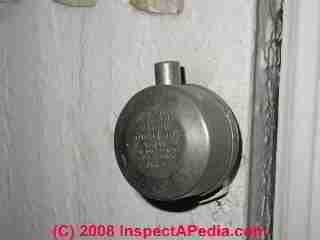 It is normal to hear a hissing sound from the steam vent as air escapes from the radiator at the start of a heating cycle.
It is normal to hear a hissing sound from the steam vent as air escapes from the radiator at the start of a heating cycle.
The hissing sound should stop and the valve close when the radiator gets hot.
Steam Vents that Do Not Shut Off When They Should
If steam continues to escape from the valve even after the radiator is hot, the valve is defective and should be replaced since continuous loss of steam increases the water consumption by the heating system.
Other causes of steam radiators to fail to get hot include a radiator valve that is shut or a steam radiator valve that has become clogged with rust and debris (more likely on a one-pipe steam heating system where returning condensate through the valve can become blocked),
or a one pipe steam radiator that has become tipped the wrong way so that it becomes clogged with condensate.
Steam Vents that Do Not Open When They Should
If a steam vent stops working and fails to open, rising steam cannot enter the radiator and it will be slow to heat or may not heat at all.
If your one pipe steam radiator won't get hot, the air vent may be clogged or it may just be worn out and need replacement.
Or as ITT states it:
If your steam radiator won't get hot
As ITT/Hoffman and all other steam vent manufacturers will tell you:
A cold upper part of the radiator may indicate the vent is plugged with scale or is malfunctioning.
See COLD STEAM HEAT RADIATORS for diagnostic and repair suggestions.
Also see this
ITT Hoffman Specialty STEAM VENTS for RADIATORS MODEL 1A 1B AIR VALVE INSTALLATION INSTRUCTIONS [PDF[ (2007), ITT
8200 N. Austin Ave.
Morton Grove, IL 60053
tel: 847-966-3700
fax: 847-966-9052
www.hoffmanspecialty.com
Excerpt:
A cold upper part of the radiator may indicate the vent is plugged with scale or is malfunctioning. Vapor or slight moisture from the vent is normal. Steam continuously passing through the vent indicates a malfunction. Replace the vent as needed or every 10 years. - Op. Cit.
Steam vents that won't close properly:
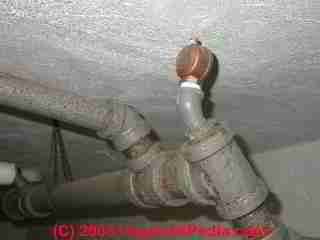 If a steam vent stops working properly and fails to close, the vent will hiss and release steam (and sometimes produce condensate or water) continually all during the heating cycle, wasting heat, increasing heating cost, and in some cases creating a moisture problem or even a burn risk at the radiator.
If a steam vent stops working properly and fails to close, the vent will hiss and release steam (and sometimes produce condensate or water) continually all during the heating cycle, wasting heat, increasing heating cost, and in some cases creating a moisture problem or even a burn risk at the radiator.
Steam vents on individual radiators or main steam vents may not be opening when they should. If an individual steam radiator vent fails to open, that radiator won't get hot even though its supply valve is open.
But if a main steam vent (master steam vent) is not opening, the whole heating system may continue to work, but we expect to see two problems:
- The steam heat rises too slowly, as the larger volume of air in the main steam riser piping is not venting from the main vent(s) - instead all of this extra volume of air has to exit through the individual radiator vents.
- Individual radiator steam vents may clog and fail more quickly by having to pass more air and moisture, or because the boiler pressure is too high.
Main steam vents: Our photo (left) shows an automatic air vent found on steam piping in a basement - not all steam vents are located right on the radiators. This is a line vent or main vent, and it too needs to work. (Most likely this is a 2 pipe steam system]
This vent may have been added to help speed rising of steam in a building by purging air from a section of steam piping.
If no air escapes from this valve during the heating cycle it may be that the valve is jammed, is not releasing air, and the steam radiator may not ever warm up.
The valve may need to be replaced if it is corroded, leaky, doesn't vent, or if the steam system appears not to be venting properly.
We also discuss this valve at STEAM VENT TYPES, SELECTION.
Noisy Steam Vents or Steam Radiators
It is normal for steam vents to make a hissing noise (also described as a whistling noise) at the start of a heating cycle while air is being vented out of the steam piping or steam radiator as it is pushed by rising steam.
Watch out: If the radiator continually makes noises (hissing, whistling or wheezing) at the steam vent, there is a problem that needs to be fixed: a bad steam vent, steam piping problem, steam pressure set too high, or boiler oversized for the heating distribution system.
First, make sure that the noise complaint is coming from the steam vent and not from water hammer or clanking steam piping.
Next: mineral deposits or dirt in a steam vent can prevent it from opening or closing properly. While it is often possible to disassemble and clean (soak in vinegar) a mineral-clogged steam vent, other internal vent failures can also occur, so considering the low cost of replacement steam vents, it usually makes sense to simply replace the steam vent entirely.
At RADIATOR STEAM VENTS, 1-PIPE SYSTEMS we list a variety of replacement steam vents.
A rattling sound at a steam vent may be heard at any radiator or at a main steam riser where a main line vent is installed. If your steam vent is rattling an internal part has become loose. Replace the vent.
Watch out: Steam condensate return problems can cause banging clanging steam heating pipes & radiators.
As we discuss
at BANGING HEATING PIPES RADIATORS, if your heating boiler does not have an automatic water feeder and you've been putting makeup water into the boiler manually, a blocked condensate line and low water in the boiler will eventually lead to total loss of heat when the low water cutoff switch.
See LOW WATER CUTOFF CONTROLS , a key boiler safety device, simply shuts down the boiler.
Also
see HEATING SYSTEM NOISE DIAGNOSIS - where we list heating system noise types, sources, problem indicators, cures
What to Do About Steam Vents that Leak or "Spit" Water
If water is "spitting" out of your steam radiator's air vent it's most likely that debris, sediment, mineral deposits, or rust flakes have partly clogged the air vent. Steam experts such as Dan Holohan suggest that you may be able to clean a spitting or partly-clogged steam vent by disassembling and boiling the vent in vinegar (to dissolve minerals).
Watch out: don't remove a steam vent when the heating system is in use or hot. You can get badly burned. But some specialty steam vents (air valves) such as the Hoffman Model 508 (Part No. 401475) can be disassembled and cleaned without removing from the line.
If a lot of water is really leaking out of a steam radiator's steam vent, the radiator may also have become waterlogged (according to some writers). We don't think this is a common problem, since most steam vents are mounted at mid radiator height or higher - the radiator would have to be really full of condensate for a lot of water to be coming out of the steam vent - unlikely.
If a steam radiator contains condensate (water from condensed steam) that fills the radiator to a level above the steam vent, the steam vent cannot function, air won't be pushed out of the radiator by rising steam, and the radiator won't heat.
If your steam vent is mostly venting steam but spits a few drops of water, the vent may not be working properly and may need replacement, but it is not as likely to be a sign that the steam system has become waterlogged.
Watch out: are you sure your system is using steam heat? Hot water radiators often include a manual air-bleeder valve that must be opened to let air out of the hot water (not steam) radiator or the radiator won't heat. On a hot water (hydronic) heating system if you leave the air bleeder valve open after air has stopped coming out, indeed water will come squirting out of the valve - indefinitely. Don't do this.
See AIR BLEEDER VALVES for details.
Automatic and thermostatically operated steam vents used to provide room temperature control are discussed in detail also at RADIATOR VALVES & HEAT CONTROLS.
Also see where we explain automatic steam vents and heat regulation using air vents on steam radiators
If you don't know what kind of heat your building uses, we explain how to figure out the answer
If your heating system is not working properly,
see NO HEAT - BOILER
...
Continue reading at STEAM RADIATOR VENT REPAIR or select a topic from the closely-related articles below, or see the complete ARTICLE INDEX.
Or see STEAM VENT FAQs - questions and answers posted originally on this page
STEAM VENT TYPES, SELECTION where we explain more about the different venting requirements for 1 pipe vs. 2 pipe steam systems, we describe the extra controls and vents needed at two-pipe steam systems.
Or see these
Recommended Articles
- COLD STEAM HEAT RADIATORS
- RADIATOR VALVES & HEAT CONTROLS
- STEAM TRAPS
- STEAM VENTS - home
- UNEVEN HEAT DIAGNOSIS
Suggested citation for this web page
STEAM VENTS at InspectApedia.com - online encyclopedia of building & environmental inspection, testing, diagnosis, repair, & problem prevention advice.
Or see this
INDEX to RELATED ARTICLES: ARTICLE INDEX to HEATING RADIATORS
Or use the SEARCH BOX found below to Ask a Question or Search InspectApedia
Ask a Question or Search InspectApedia
Questions & answers or comments about steam vents on steam heating radiators and convectors
Try the search box just below, or if you prefer, post a question or comment in the Comments box below and we will respond promptly.
Search the InspectApedia website
Note: appearance of your Comment below may be delayed: if your comment contains an image, photograph, web link, or text that looks to the software as if it might be a web link, your posting will appear after it has been approved by a moderator. Apologies for the delay.
Only one image can be added per comment but you can post as many comments, and therefore images, as you like.
You will not receive a notification when a response to your question has been posted.
Please bookmark this page to make it easy for you to check back for our response.
Our Comment Box is provided by Countable Web Productions countable.ca
Citations & References
In addition to any citations in the article above, a full list is available on request.
- Barnes & Jones Corporation, 91 Pacella Park Drive Randolph, MA 02368, Tel: 781-963-8000calibrated steam traps and vents, Email: bnesbitt@barnesandjones.com. Vent-Rite steam vents for radiator control.
- Energy Savers: Heat Distribution Systems, Steam Radiators & Hot Water Radiators, U.S. Department of Energy, web search 12/27/2010, original source: http://www.energysavers.gov/your_home
/space_heating_cooling/index.cfm/mytopic=12580 - Gorton Heating Corporation, 546 South Avenue East, Cranford, New Jersey 07016, Tel: 908-276-1323, email: info@gorton-valves.com, fast venting valves for steam heating systems.
- "Rv-4 One-Pipe Steam Radiator Valve", available from Armstrong International,
816 Maple Street, Three Rivers, MI 49093 USA, Tel: (269) 273-1415, Armstrong has offices in Beijing, China, Belgium, India and Mexico. Web search 12/27/2010, original source:
http://www.armstronginternational.com/thermostatic-valves-rv-4-one-pipe. - "Special Steam Vents", Hoffman Specialty heating products, web search 12/27/2010, original source:
http://www.hoffmanspecialty.com/pdf/hs900/HS900-3474.pdf - "Steam and Water Vents, Selection Guidelines - Steam Vents", Hoffman Specialty, web search 12/27/2010, original source:
http://www.hoffmanspecialty.com/pdf/hs900/HS900-stvents.pdf - Hoffman 1A adjustable steam vents, available from Hoffman Specialty, ITT, web search 12/27/2010, original source:
http://www.drillspot.com/products/51570/Hoffman_1A_Adjustable_Automatic_Air_Vent_For_Steam_Radiators - Hoffman Convector Steam Vents, available from Hoffman Specialty, ITT, web search 12/28/2010, original source:
http://www.hoffmanspecialty.com/pdf/hs900/HS900-conv109.pdf - Report 95-14, PB96-198163 Thermostatic Radiator Valve (TRV) Demonstration Project, contact NYSERDA. 17 Columbia Circle, Albany, NY 12203-6399 Toll-Free: 1-866-NYSERDA, Tel:(518)465-6252, Ext. 241. Web Search 12/27/2010, original source: http://www.homeenergy.org/archive/hem.dis.anl.gov/eehem/96/960509.html
- VariValve® Quick-Vent from Heat Timer, adjustable radiator and main line vent valves for one pipe steam systems, web search 12/27/2010, original source: http://www.heat-timer.com/enFiles/ProductDocument/literature/VariV056082C.pdf
- "Care & Feeding of Air Vents", Dan Holohan, Old House Journal Online, November 2004
- The Steam Book, 1984, Training and Education Department, Fluid Handling Division, ITT [probably out of print, possibly available from several home inspection supply companies] Fuel Oil and Oil Heat Magazine, October 1990, offers an update, (see next item in this list). ITT Fluid Technology,
1133 Westchester Avenue
White Plains, NY 10604, tel +1 914 304 1700 fax +1 914 696 2950 www.ittfluidbusiness.com - Principles of Steam Heating, $13.25 includes postage. Fuel oil & Oil Heat Magazine, 389 Passaic Ave., Fairfield, NJ 07004.
- The Lost Art of Steam Heating, Dan Holohan, 516-579-3046 FAX
- Principles of Steam Heating, Dan Holohan, technical editor of Fuel Oil and Oil Heat magazine, 389 Passaic Ave., Fairfield, NJ 07004 ($12.+1.25 postage/handling).
- "Residential Steam Heating Systems", Instructional Technologies Institute, Inc., 145 "D" Grassy Plain St., Bethel, CT 06801 800/227-1663 [home inspection training material] 1987
- The Heat Efficiency of Steam Boilers, Bryan Donkin
- Steam Boiler Operation, Principles & Practice, James J. Jackson
- The Steam Book, 1984, Training and Education Department, Fluid Handling Division, ITT [probably out of print, possibly available from several home inspection supply companies] Fuel Oil and Oil Heat Magazine, October 1990, offers an update,
- Principles of Steam Heating, $13.25 includes postage. Fuel oil & Oil Heat Magazine, 389 Passaic Ave., Fairfield, NJ 07004.
- The Lost Art of Steam Heating, Dan Holohan, 516-579-3046 FAX
- Principles of Steam Heating, Dan Holohan, technical editor of Fuel Oil and Oil Heat magazine, 389 Passaic Ave., Fairfield, NJ 07004 ($12.+1.25 postage/handling).
- "Residential Steam Heating Systems", Instructional Technologies Institute, Inc., 145 "D" Grassy Plain St., Bethel, CT 06801 800/227-1663 [home inspection training material] 1987
- "Residential Hydronic (circulating hot water) Heating Systems", Instructional Technologies Institute, Inc., 145 "D" Grassy Plain St., Bethel, CT 06801 800/227-1663 [home inspection training material] 1987
- Heating, Ventilating, and Air Conditioning Volume I, Heating Fundamentals,
- Boilers, Boiler Conversions, James E. Brumbaugh, ISBN 0-672-23389-4 (v. 1) Volume II, Oil, Gas, and Coal Burners, Controls, Ducts, Piping, Valves, James E. Brumbaugh, ISBN 0-672-23390-7 (v. 2) Volume III, Radiant Heating, Water Heaters, Ventilation, Air Conditioning, Heat Pumps, Air Cleaners, James E. Brumbaugh, ISBN 0-672-23383-5 (v. 3) or ISBN 0-672-23380-0 (set) Special Sales Director, Macmillan Publishing Co., 866 Third Ave., New York, NY 10022. Macmillan Publishing Co., NY
- Our recommended books about building & mechanical systems design, inspection, problem diagnosis, and repair, and about indoor environment and IAQ testing, diagnosis, and cleanup are at the InspectAPedia Bookstore. Also see our Book Reviews - InspectAPedia.
- In addition to citations & references found in this article, see the research citations given at the end of the related articles found at our suggested
CONTINUE READING or RECOMMENDED ARTICLES.
- Carson, Dunlop & Associates Ltd., 120 Carlton Street Suite 407, Toronto ON M5A 4K2. Tel: (416) 964-9415 1-800-268-7070 Email: info@carsondunlop.com. Alan Carson is a past president of ASHI, the American Society of Home Inspectors.
Thanks to Alan Carson and Bob Dunlop, for permission for InspectAPedia to use text excerpts from The HOME REFERENCE BOOK - the Encyclopedia of Homes and to use illustrations from The ILLUSTRATED HOME .
Carson Dunlop Associates provides extensive home inspection education and report writing material. In gratitude we provide links to tsome Carson Dunlop Associates products and services.


